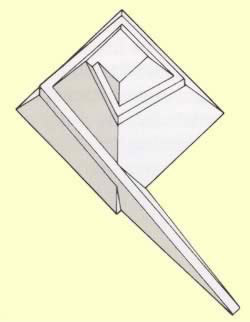
Ramps-
Ramps are the most common explanation for how the blocks were raised onto the pyramids. This theory is derived from conventional engineering, artwork depicting construction sites, and archaeological finds where ramps were used in an unfinished temple construction site.
The concept of ramp in relation to physics is that much of the force of gravity caused by mass of the heavy blocks will be redirected into the ramp allowing vertical climb with less work over a longer distance

Straight Ramp-
One straight ramp wouldn’t have been a viable
method of raising the blocks as shallow angle of declination that
would be necessary to move the blocks would have meant the ramps
would be significantly larger than the base of the pyramid being
constructed. For reference if this design had been used for the
Great Pyramid the ramp would have stretched over a mile away from
the pyramid itself and used three times as much construction
material as the pyramid.

Zig Zag Ramp–
With the infeasibility of
the straight ramp apparent the zig-zag ramp was proposed.

This ramp system would work through having the ramp wrap around the pyramid. The zig-zag method would come with several engineering problems. Turning the blocks at the corners of the ramp would be extremely difficult with the mass and forces involved. Another problem would be the sheer immensity of the ramp itself. The length of loading the rap when approaching the top would be similar to the straight ramps size meaning it would be immense. In addition to this the forces of the ramp resting on the uncompleted pyramid would put immense strain on the not yet stable pyramid and would have been unlikely to work.
Timber Levers –
Timber levers are another suggested lifting device for the blocks used in the pyramids. The concept is that a line of levers and counterweights was used to lift the blocks up a face of pyramid in question.

Levers work through amplifying the input force to lift a more massive object. The tradeoff is in the greater distance from the fulcrum you must apply the smaller force to move the larger object. Like with all other methods of the blocks the engineering and physics behind the larger blocks being moved are boggling. You would need very long lever arms or very heavy counterweights while at the same time needing very strong materials to support the massive loads.
Evidence of lever systems exist in Egypt with
the use of simple machines such as the Shadoof which was used to
extract pots of water from the Nile.